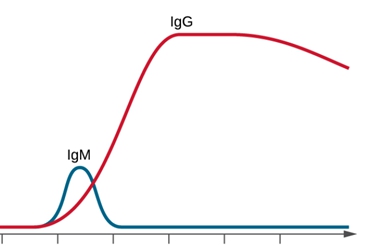In this video, we're going to begin our lesson on the primary and secondary responses of adaptive immunity. It's important to recall from some of our previous lesson videos that memory cells, specifically memory B cells and memory T cells, are really important for generating an adaptive immune response towards future infections, but they're not really involved with the primary or the initial infection. Here, we're telling you that these memory B cells and memory T cells are capable of making a secondary adaptive immune response significantly faster and more effective than the primary immune response or the initial immune response when you're first responding to an antigen for the very first time.
Below, we distinguish between the primary immune response and the secondary immune response. The primary immune response, as its name implies, is a relatively slower and weaker immune response upon initial exposure to an antigen. For example, it's actually going to take more time to produce a relatively low number of IgM antibodies. The secondary immune response, as its name implies, is a significantly faster and stronger immune response upon a secondary exposure to an antigen. Or the second time you are exposed to the same antigen, your immune response will be significantly faster and stronger, allowing your body to eliminate the antigen more effectively. For example, it will take significantly less time to produce a relatively high number of IgG antibodies, the more effective antibody, and only some IgM antibodies. The secondary immune response is also associated with the memory B and T cells of adaptive immunity. Really, it's these memory B and T cells that allow for the faster and stronger immune response.
If we take a look at our image below, we can further differentiate between the primary immune response, which we have on the left-hand side, and the secondary immune response, which we have on the right. On the x-axis, we have time in weeks, and on the y-axis, we have the antibody concentration in the blood serum or the number of antibodies. Initially exposed to an antigen, it can take multiple weeks in some cases for your body to be able to produce antibodies. The very first class of antibody that's going to be produced initially is the IgM antibody, which you might recall is one of the important details you should know about the IgM antibody, that it's the very first class that's going to be produced. Antibody class switching will allow the B cells and plasma cells to switch from releasing IgM to releasing a more effective antibody, in this case, the IgG antibody. The relative numbers of these antibodies will be lower in the primary response compared to the numbers in the secondary response. After your body eliminates the antigen in the primary response, if you ever encounter the same specific antigen in the future in a secondary response, the time for your body to start producing antibodies is much shorter, much less than two weeks here in this first period. It could be less than a week, for example. Your body is able to start producing the more effective antibody class, the IgG antibody class, significantly faster and in significantly higher numbers, allowing you to create a more effective immune response the second time you are exposed to something.
Often with a secondary response, your body is so effective at getting rid of the same antigen that your body may not even develop signs or symptoms because the antigen is eliminated before your body even has a chance to generate signs and symptoms. Basically, the primary immune response, the very initial exposure to an antigen, will take more time and create a less effective immune response. But the second time you are exposed to the same antigen, your body will create antibodies significantly faster and in significantly higher numbers allowing your body to create a more effective immune response in a secondary exposure. If there were to be a tertiary exposure, then the response would be even better than the secondary response. That would continue to happen as you are exposed to the same antigen over time. Your body gets better and better at defending itself. This concludes our brief lesson on the primary and secondary responses of adaptive immunity, and how these memory B and T cells are critical for the secondary and all future responses of adaptive immunity. We'll be able to get some practice applying these concepts as we move forward in our course. So, I'll see you all in our next video.


